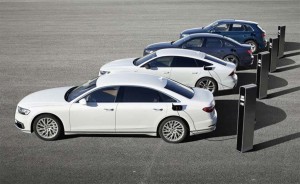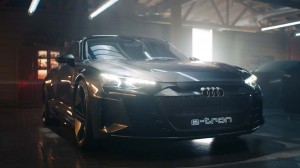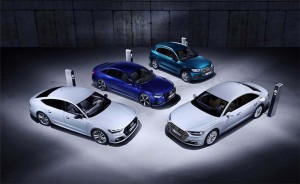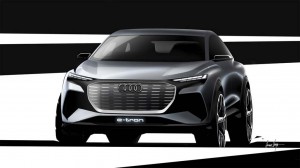We’ve been hearing a lot about Audi’s plans for all-electric models like the new e-tron and the planned e-tron GT that debuted at the Los Angeles Auto Show last November. The automaker even made that the subject of a well-received ad during this month’s Super Bowl. And it has another model, the Q4 e-tron coming to Geneva.
But the luxury brand has a much broader electrification strategy under development and it plans to put an assortment of plug-in hybrids under the spotlight during its news conference at the Geneva Motor Show next month.
In all, the event will mark the debut of four during PHEVs, including versions of the A6, A7 and A8 sedans, as well as the Q5 sport-utility vehicle. The show will also see a shift in Audi’s battery-car nomenclature. Going forward, plug-in hybrids will be referred to with the designation “TFSI e,” rather than e-tron.
“At Audi the topic of electrification in particular will take center stage,” Audi AG marketing and sales chief Martin Sander explained.
(Click Here to see Iron Man help Audi unveil the e-Tron GT Concept.)

The four PHEVs will use essentially the same powertrain technology but different types of batteries.
The basic drivetrain technology will vary just slightly between the new models, For the A8 L 60 TFSI e, an electric motor is integrated within its eight-speed automatic gearboxes. It will make a combined system output of 443 horsepower and 516 pound-feet of torque by pairing the motorized gearbox to a 3.0-liter V-6.
The A6, A7 and Q5 plug-ins will be offered in two distinct versions, both swapping the 8-speed for a dual-clutch gearbox also containing an electric motor. The “comfort” models will deliver a more modest 295 hp and 332 lb-ft, while the “performance” versions will bump that up to 363 hp and 369 lb-ft. Those models also share details found on the conventional Audi S Line, including a sport suspension, larger, red brakes and black accents.
There’s another subtle difference: the Q5 uses prismatic lithium-ion battery cells while the other models opt for 104 pouch cells.
Batteries are mounted underneath the cargo compartment and, at 14.1 kilowatt-hours, are expected to deliver around 25 miles range – in the European WLTP cycle, anyway, with U.S. range likely to be as much as a third lower.

Audi focused on its all-electric plans - with models like the e-tron GT concept - in its Super Bowl ad.
(Click Here for a sneak peek at the new Audi Q4 e-tron Concept.)
To help maximize range, the transmission motors can serve as a generator under light braking or coasting. Under more aggressive deceleration, conventional hydraulic brakes take over.
To minimize energy usage, especially in EV mode, the new Audis integrate an efficient heat pump system. Drivers have a choice of a number of different modes that can help decide whether to use some energy from the battery or hold it for later. That’s a potential advantage, with some European cities planning on banning or penalizing vehicles that aren’t operating in zero-emissions mode.
The four Audi plug-ins will come with a 7.2 kilowatt charger but motorists can also option the vehicle to be able to plug into a Level 3 quick charger for getting an 80% top-off in a matter of minutes.
Audi is playing a bit of catch-up with its German rival Mercedes-Benz which currently has about 10 different plug-in hybrids in its line-up.
Both automakers, as well as Bavarian-based BMW, plan to have electrified options – ranging from conventional hybrids to full battery-electric vehicles – for virtually all of their model lines in the coming decade.
All three brands have been tinkering with their electrification strategies. Audi had, until now, used the “e-tron” badge for pretty much anything using some form of battery-based propulsion. Going forward, however, that nomenclature will be reserved specifically for its all-electric models.
It plans to show off yet another BEV during the Geneva Motor Show in the form of the new Q4 e-tron prototype.
(Volvo is launching an all-new family of electrified powertrains in Geneva. Click Here for more.)


